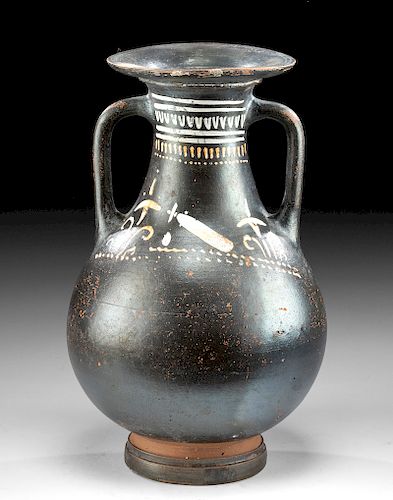Greek Gnathian Pottery Pelike w/ Alabastron Motif
Lot 55
About Seller
Artemis Fine Arts
686 S Taylor Ave, Ste 106
Louisville, CO 80027
United States
Selling antiquities, ancient and ethnographic art online since 1993, Artemis Gallery specializes in Classical Antiquities (Egyptian, Greek, Roman, Near Eastern), Asian, Pre-Columbian, African / Tribal / Oceanographic art. Our extensive inventory includes pottery, stone, metal, wood, glass and textil...Read more
Categories
Estimate:
$2,400 - $3,600
Absentee vs Live bid
Two ways to bid:
- Leave a max absentee bid and the platform will bid on your behalf up to your maximum bid during the live auction.
- Bid live during the auction and your bids will be submitted real-time to the auctioneer.
Bid Increments
| Price | Bid Increment |
|---|---|
| $0 | $25 |
| $300 | $50 |
| $1,000 | $100 |
| $2,000 | $250 |
| $5,000 | $500 |
| $10,000 | $1,000 |
| $20,000 | $2,500 |
| $50,000 | $5,000 |
| $100,000 | $10,000 |
| $200,000 | $20,000 |
About Auction
By Artemis Fine Arts
Jan 16, 2020
Set Reminder
2020-01-16 10:00:00
2020-01-16 10:00:00
America/New_York
Bidsquare
Bidsquare : Ancient | Asian | Ethnographic
https://www.bidsquare.com/auctions/artemis-gallery/ancient-asian-ethnographic-4799
Featuring classical antiquities, ancient and ethnographic art from cultures encompassing the globe. Artemis Fine Arts info@artemisgallery.com
Featuring classical antiquities, ancient and ethnographic art from cultures encompassing the globe. Artemis Fine Arts info@artemisgallery.com
- Lot Description
Magna Graecia, South Italic Colonies, Apulia, near Ignazia, ca. 340 to 325 BCE. An attractive wheel-thrown pottery vessel of a sizable form known as a "pelike" (wine container). The elegant form of the pelike is composed of a squat foot and stem, a rotund piriform body with a tapered shoulder, a cylindrical neck surmounted by a flared rim, and a pair of applied strap handles arching between neck and shoulder. The exterior of the vessel is embellished with lustrous, jet-black glaze save for a reserve band around the foot as well as beneath the foot. Fugitive white and orange pigment creates concentric stripes, frets, V-form motifs, and stippling around the neck, and a diagonal representation of a lidded alabastron is flanked by a pair of foliate forms on one side of the shoulder. Fine layers of silvery iridescence have formed across the composition and create a dignified presentation. Size: 5.2" W x 8.4" H (13.2 cm x 21.3 cm)
For a stylistically similar example of an Apulian pelike decorated with a lady of fashion, please see The Metropolitan Museum of Art, accession number 76.12.12.
Provenance: private J.H. collection, Beaverton, Oregon, USA, acquired prior to 2007; ex-Aaron Berk collection, Chicago, Illinois, USA
All items legal to buy/sell under U.S. Statute covering cultural patrimony Code 2600, CHAPTER 14, and are guaranteed to be as described or your money back.
A Certificate of Authenticity will accompany all winning bids.
We ship worldwide and handle all shipping in-house for your convenience.
#149650Professional repair to one handle, with resurfacing and light overpainting along break lines. Minor abrasions and pitting along foot, body, handles, and rim, with light fading to scattered areas of original glaze, and chipping and staining to some areas of fugitive pigment. Light earthen deposits throughout, and fine silver iridescence along glazed areas.Condition
- Shipping Info
-
All shipping is handled in-house for your convenience. Your invoice from Artemis Gallery will include shipping calculation instructions. If in doubt, please inquire BEFORE bidding for estimated shipping costs for individual items.
-
- Buyer's Premium



 EUR
EUR CAD
CAD AUD
AUD GBP
GBP MXN
MXN HKD
HKD CNY
CNY MYR
MYR SEK
SEK SGD
SGD CHF
CHF THB
THB
















